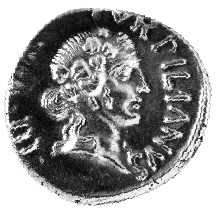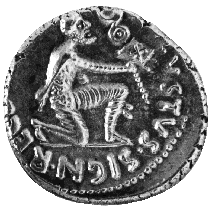



(63) Augustus - AR denarius, c. 19 B.C., 3.93 g. (inv. 91.115).
Obverse: Head of Liber r.; TVRPILIANVS III VIR: Turpilianus, triumvir.
Reverse: Parthian kneeling r., offering standard with vexillum in
r., holding out l.;
[CAESAR A]VGVSTVS SIGN(IS) RECE(PTIS): Caesar Augustus; standards retaken.
Provenance: Edward Gans, 1960.
Bibliography: C.H.V. Sutherland, The Roman Imperial Coinage I: from 31
BC to AD 69, rev. ed. (London 1984) 287.
This coin refers to the event that Augustus regarded as his greatest diplomatic
achievement, the recovery in 20 B.C. of legionary standards and prisoners
captured by the Romans' long-time enemies, the Parthians. On the reverse
is a kneeling Parthian, identified as a barbarian by his native dress, extending
a standard with a vexillum or flag attached to it in his right hand.
The standards had been lost by others in earlier operations against the
Parthians, by M. Crassus at the battle of Carrhae in 53 B.C., by Decidius
Saxa in Syria in 40 B.C., and by Marc Antony in his invasion of Armenia
in 36 B.C. The surrender was achieved by diplomatic means, but it accompanied
the recovery of Armenia, and in Rome it was regarded as a military victory
for which the Senate voted Augustus a triumph. Augustus refused the full
triumphal celebration, but he allowed his triumphal insignia to be displayed,
and an arch was erected in the Forum Romanum to commemorate the event. The
recovered standards were placed in the small round Temple of Mars Ultor
(Mars the Avenger) built especially for them (see no. 64).
This coin comes from one of the last series to bear the names and symbols
of the triumviri monetales, the board of three officials in charge
of minting; their names and symbols had been a regular feature of republican
coinage. The coins of Publius Petronius Turpilianus feature nature deities;
the head on the obverse is Liber, an Italian god of wine commonly identified
with Bacchus.
C.L.L.



All contents copyright (c) 1996.
Lawrence University
All rights reserved.